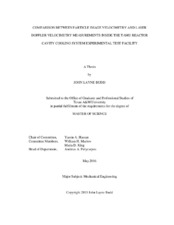| dc.description.abstract | To further efforts for studying the TAMU air-cooled Reactor Cavity Cooling System (RCCS) experimental test facility, Laser Doppler Velocimetry (LDV) experiments have been conducted to acquire data on the instantaneous streamwise and spanwise components of velocity at various locations inside the upper plenum. These experiments were performed under steady-state conditions, both heated and adiabatic, using four active risers. The apparatus used for data acquisition consisted primarily of a 2-D laser head mounted onto a 3-D traverse system. Olive oil particles with an average diameter of 0.745 µm were utilized for seeding the flow.
The data from these experiments has been necessary for characterizing the experimental facility by verifying the system’s repeatability and performance. In addition, LDV measurements have provided means of comparison for previously acquired PIV measurements. The compared parameters include the streamwise velocity component, as well as the streamwise and spanwise components of the turbulent intensity and the Reynolds stresses.
Based on these comparisons, several differences were found between the two techniques. First, the PIV turbulent statistics did not generally agree well with those of the LDV measurements. However, data points located at regions of higher elevation tended to have better agreement. These higher regions are characterized by velocity gradients significantly smaller than those found at lower elevations. This fact may aid in explaining the discrepancies between the techniques, since PIV is known to underperform on regions with high velocity gradients. In addition, it is suspected that the number of samples for PIV, 150 in total, were insufficient for obtaining reasonable statistics. This is in contrast to LDV, which had 1500 samples per data point. Second, the comparison between the techniques appear to agree better for the adiabatic case than the heated case. Since the heated case has additional turbulence fluctuations induced by thermal mixing, this may have hindered the PIV measurements. Third, the turbulence intensities were consistently overestimated by PIV. This led to the conclusion that the PIV data contained significantly more noise than LDV data.
Aside from comparisons between the two techniques, several experiments were conducted to test the repeatability and accuracy of the LDV measurements. It was found that the LDV measurements exhibited good accuracy and a high level of repeatability. Throughout these measurements, the standard deviation percentage was found to be no greater than 10%. More importantly, when averaging the values of all data points at each respective each elevation, the average value ranged between 2.2% and 3.5%. | en |


